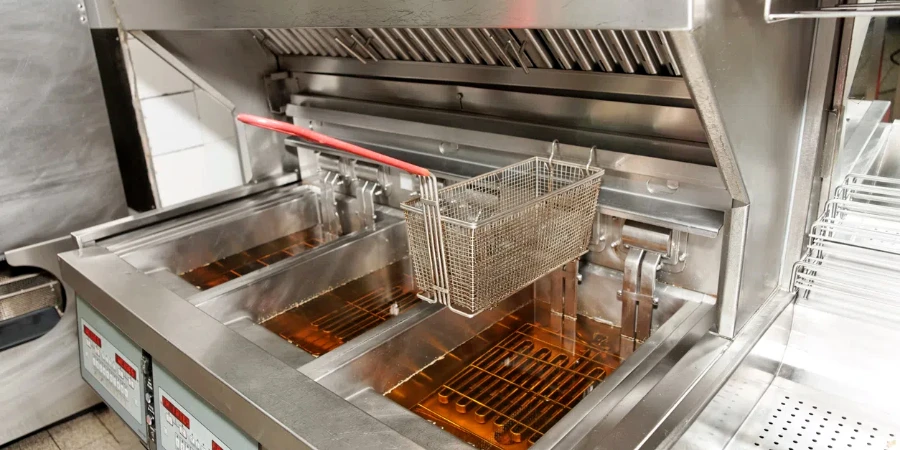As the global fast food market is projected to grow at a CAGR of 4.6% from 2024 to 2029, the demand for commercial fryers is on the rise. This growth is driven by the expansion of the foodservice industry and technological advancements in frying equipment. Understanding the key factors and trends in the commercial fryer market is crucial for business buyers looking to stock and sell these products.
Table of Contents:
– Understanding the Commercial Fryer Market
– Types of Commercial Fryers
– Essential Features to Consider
– Trends in Commercial Fryer Technology
– Cost Analysis and Budgeting
– Making an Informed Purchase Decision
Understanding the Commercial Fryer Market
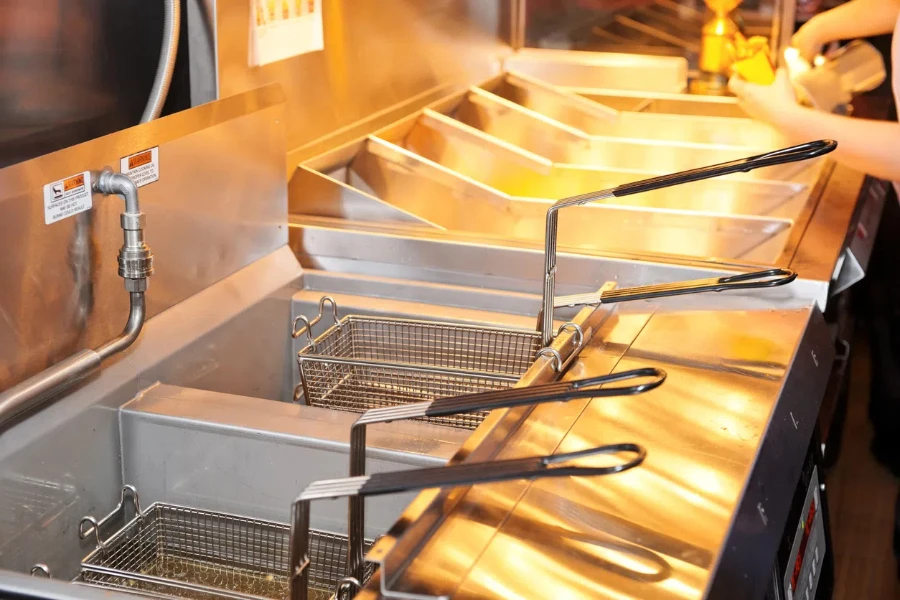
Key Market Drivers
The commercial fryer market is driven by several key factors, including the increasing demand for fast food and the expansion of the foodservice industry. The global fast food market is projected to grow at a CAGR of 4.6% from 2024 to 2029, which directly influences the demand for commercial fryers. Additionally, the rise in the number of quick-service restaurants (QSRs) and food trucks has significantly contributed to the market growth. The QSR market alone is expected to reach a valuation of USD 308.5 billion by 2025, further propelling the need for efficient frying equipment.
Technological advancements in commercial fryers, such as the integration of IoT and automation, are also key market drivers. These innovations enhance operational efficiency, reduce oil consumption, and improve food quality, making them attractive to foodservice operators. For instance, the adoption of smart fryers that can be monitored and controlled remotely is expected to increase by 15% annually, reflecting the industry’s shift towards automation.
Health-conscious consumer trends are another significant driver. The growing awareness of the health risks associated with deep-fried foods has led to the development of fryers that use less oil and offer healthier frying options. The global air fryer market, which is a subset of the commercial fryer market, is expected to grow at a CAGR of 10.16% from 2024 to 2029, indicating a strong preference for healthier frying methods.
Leading Manufacturers and Brands
The commercial fryer market is dominated by several key manufacturers and brands that have established a strong presence globally. Companies like Henny Penny, Frymaster, and Pitco are among the leading players, known for their innovative and high-quality frying solutions. Henny Penny, for instance, reported a revenue of USD 500 million in 2023, with a significant portion attributed to its commercial fryer segment.
Frymaster, a subsidiary of Welbilt, is another major player, renowned for its energy-efficient and technologically advanced fryers. The company’s market share in the commercial fryer segment is estimated to be around 20%, with annual sales exceeding USD 300 million. Pitco, a part of the Middleby Corporation, also holds a substantial market share, with its products being widely used in QSRs and large food chains.
Other notable brands include Vulcan, Anets, and Dean, each offering a range of fryers tailored to different commercial needs. These companies continuously invest in research and development to introduce new features and improve the efficiency of their products. For example, Vulcan’s latest line of fryers boasts a 30% reduction in oil usage, aligning with the industry’s move towards sustainability and cost-efficiency.
Regional Market Analysis
The commercial fryer market exhibits significant regional variations, with North America, Europe, and Asia-Pacific being the major markets. North America, particularly the United States, leads the market with a revenue of USD 1.59 billion in 2024, driven by the high concentration of fast food chains and QSRs. The market in this region is expected to grow at a CAGR of 8.40% from 2024 to 2029, reflecting the ongoing expansion of the foodservice industry.
Europe is another key market, with countries like the United Kingdom, Germany, and France showing substantial demand for commercial fryers. The UK market, for instance, is projected to generate USD 154.10 million in revenue in 2024, with an annual growth rate of 10.39%. This growth is attributed to the increasing popularity of fast food and the adoption of advanced frying technologies in the region.
Asia-Pacific is the fastest-growing market, with China leading the way. The revenue generated from the commercial fryer market in China is expected to reach USD 1.635 billion in 2024. The region’s market growth is driven by the rapid urbanization, rising disposable incomes, and the proliferation of fast food outlets. The volume of commercial fryers in the Asia-Pacific market is expected to grow by 9.2% in 2025, indicating a robust demand for frying equipment.
Types of Commercial Fryers
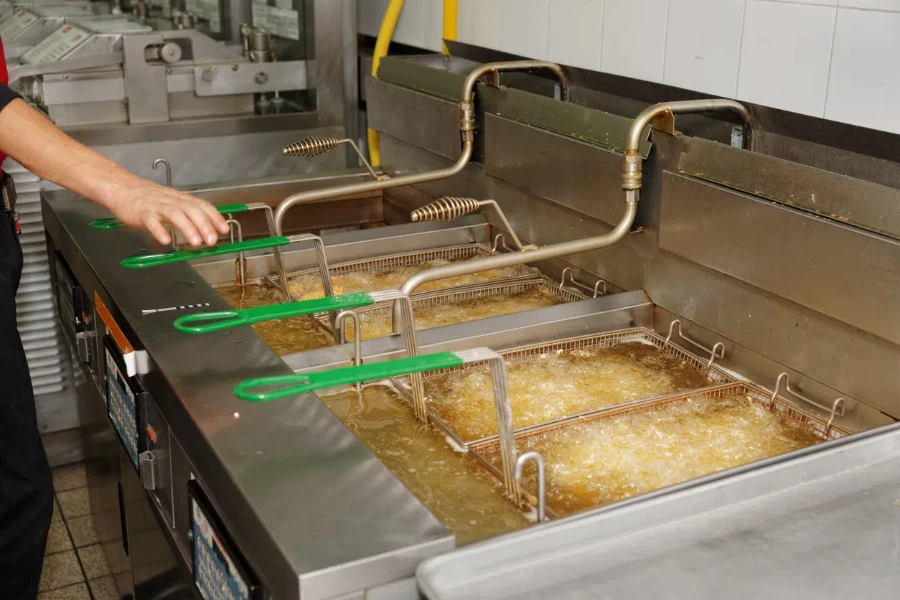
Countertop Fryers
Countertop fryers are compact and versatile, making them ideal for small to medium-sized foodservice operations. These fryers are designed to fit on countertops, saving valuable kitchen space while providing efficient frying capabilities. They are particularly popular in food trucks, small cafes, and concession stands due to their portability and ease of use.
The market for countertop fryers is expected to grow significantly, driven by the increasing number of small foodservice establishments. In 2024, the global revenue for countertop fryers is projected to reach USD 500 million, with a CAGR of 7.5% from 2024 to 2029. These fryers are available in both electric and gas models, with electric fryers being more popular due to their energy efficiency and ease of installation.
Technological advancements have also enhanced the functionality of countertop fryers. Modern models come equipped with features such as digital temperature controls, automatic filtration systems, and programmable cooking settings. These innovations not only improve the frying process but also ensure consistent food quality, making countertop fryers a preferred choice for many foodservice operators.
Floor Fryers
Floor fryers are designed for high-volume frying operations, making them suitable for large restaurants, hotels, and catering services. These fryers are typically larger and more powerful than countertop models, offering greater oil capacity and higher frying output. Floor fryers are essential for establishments that require continuous frying throughout the day.
The market for floor fryers is substantial, with a projected revenue of USD 1.2 billion in 2024. The demand for these fryers is driven by the growth of large-scale foodservice operations and the need for efficient, high-capacity frying solutions. Floor fryers are available in various configurations, including open pot, tube type, and flat bottom, each designed for specific frying needs.
Energy efficiency and ease of maintenance are key considerations for floor fryers. Many modern floor fryers feature advanced filtration systems that extend the life of the oil and reduce operating costs. Additionally, innovations such as infrared burners and high-efficiency heat exchangers have improved the energy efficiency of these fryers, making them more cost-effective and environmentally friendly.
Pressure Fryers
Pressure fryers are specialized fryers that cook food under pressure, resulting in faster cooking times and juicier, more flavorful results. These fryers are commonly used in establishments that serve fried chicken, as the pressure cooking method helps retain moisture and enhance the flavor of the chicken. Pressure fryers are a staple in many fast food chains and chicken restaurants.
The market for pressure fryers is expected to grow at a CAGR of 6.8% from 2024 to 2029, with a projected revenue of USD 800 million in 2024. The demand for pressure fryers is driven by the popularity of fried chicken and the need for efficient, high-quality frying solutions. These fryers are available in both electric and gas models, with gas models being preferred for their faster heating capabilities.
Safety features are a critical aspect of pressure fryers. Modern pressure fryers come equipped with safety mechanisms such as pressure relief valves, locking lids, and automatic shut-off systems to prevent accidents and ensure safe operation. These features, combined with the superior cooking results, make pressure fryers a valuable investment for foodservice operators.
Specialty Fryers
Specialty fryers are designed for specific frying needs, such as funnel cake fryers, donut fryers, and fish fryers. These fryers are tailored to the unique requirements of different types of fried foods, ensuring optimal cooking results. Specialty fryers are commonly used in bakeries, seafood restaurants, and food festivals, where specific frying capabilities are essential.
The market for specialty fryers is niche but growing, with a projected revenue of USD 300 million in 2024. The demand for these fryers is driven by the popularity of specialty fried foods and the need for equipment that can deliver consistent, high-quality results. Specialty fryers are available in various sizes and configurations, catering to the specific needs of different foodservice operations.
Innovations in specialty fryers have focused on improving efficiency and ease of use. Features such as programmable cooking settings, automatic oil filtration, and digital temperature controls have enhanced the functionality of these fryers. These advancements not only improve the frying process but also ensure consistent food quality, making specialty fryers a valuable addition to any foodservice operation.
Essential Features to Consider
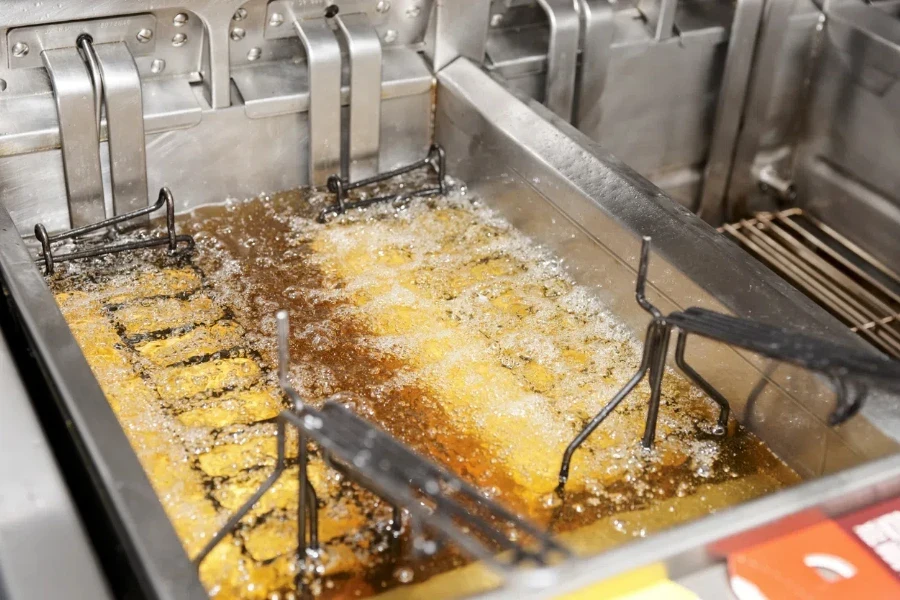
Capacity and Size
When selecting a commercial fryer, capacity and size are crucial factors to consider. The capacity of a fryer determines the volume of food that can be cooked at one time, which is essential for meeting customer demand during peak hours. Fryers with larger capacities are ideal for high-volume operations, while smaller fryers are suitable for establishments with limited space or lower frying needs.
The size of the fryer also impacts its placement and integration into the kitchen layout. Countertop fryers are compact and space-saving, making them ideal for small kitchens or food trucks. Floor fryers, on the other hand, require more space but offer higher capacities and are better suited for large-scale operations. The choice between electric and gas models also affects the size and installation requirements of the fryer.
In 2024, the average capacity of commercial fryers is expected to range from 15 to 50 pounds of oil, depending on the type and model. The market for high-capacity fryers is projected to grow at a CAGR of 7.2% from 2024 to 2029, driven by the increasing demand for efficient, high-volume frying solutions. Selecting the right capacity and size ensures that the fryer meets the operational needs of the establishment while optimizing kitchen space.
Temperature Control
Accurate temperature control is essential for achieving consistent frying results and ensuring food safety. Commercial fryers with precise temperature control systems allow operators to maintain the desired frying temperature, which is crucial for producing high-quality fried foods. Temperature fluctuations can lead to uneven cooking, oil degradation, and increased operating costs.
Modern commercial fryers are equipped with advanced temperature control features, such as digital thermostats, programmable settings, and automatic temperature recovery systems. These features ensure that the fryer maintains a consistent temperature throughout the cooking process, resulting in evenly cooked and crispy fried foods. In 2024, the market for fryers with advanced temperature control systems is expected to reach USD 1.1 billion, reflecting the growing demand for precision frying equipment.
Temperature control systems also contribute to energy efficiency and oil management. Fryers with rapid temperature recovery capabilities reduce the time required to heat the oil, leading to lower energy consumption and faster cooking times. Additionally, maintaining a consistent temperature helps extend the life of the oil, reducing the frequency of oil changes and lowering operating costs.
Energy Efficiency
Energy efficiency is a critical consideration for commercial fryers, as it directly impacts operating costs and environmental sustainability. Energy-efficient fryers consume less power, reduce utility bills, and minimize the carbon footprint of the foodservice operation. The demand for energy-efficient fryers is driven by the increasing focus on sustainability and cost savings in the foodservice industry.
In 2024, the market for energy-efficient commercial fryers is projected to generate USD 1.5 billion in revenue, with a CAGR of 8.5% from 2024 to 2029. These fryers are designed with features such as high-efficiency burners, improved insulation, and advanced heat exchangers that optimize energy use. Electric fryers are generally more energy-efficient than gas models, making them a popular choice for establishments looking to reduce their energy consumption.
Government regulations and incentives also play a role in promoting energy-efficient fryers. Many countries offer rebates and tax incentives for businesses that invest in energy-efficient equipment, further driving the adoption of these fryers. The Energy Star certification is a key indicator of energy efficiency, and fryers with this certification are preferred by many foodservice operators for their cost-saving and environmental benefits.
Safety Features
Safety is a paramount concern in commercial kitchens, and commercial fryers must be equipped with robust safety features to prevent accidents and ensure safe operation. Common safety features in commercial fryers include automatic shut-off systems, high-temperature limit controls, and pressure relief valves. These features help prevent overheating, oil spills, and other hazards associated with frying.
In 2024, the market for commercial fryers with advanced safety features is expected to reach USD 1.3 billion, driven by the increasing emphasis on kitchen safety and regulatory compliance. Fryers with built-in fire suppression systems are particularly important in high-risk environments, such as fast food restaurants and large-scale frying operations. These systems automatically detect and extinguish fires, providing an additional layer of protection.
User-friendly safety features, such as cool-touch handles and splash guards, also enhance the safety of commercial fryers. These features reduce the risk of burns and injuries, making the frying process safer for kitchen staff. The adoption of fryers with comprehensive safety features is expected to grow at a CAGR of 7.8% from 2024 to 2029, reflecting the industry’s commitment to ensuring safe and efficient frying operations.
Cleaning and Maintenance
Efficient cleaning and maintenance are essential for the longevity and performance of commercial fryers. Regular cleaning prevents the buildup of grease and food particles, which can affect the quality of the fried food and pose a fire hazard. Easy-to-clean fryers reduce downtime and labor costs, making them a preferred choice for busy foodservice operations.
In 2024, the market for commercial fryers with advanced cleaning and maintenance features is projected to generate USD 1.4 billion in revenue. These fryers are designed with features such as removable oil tanks, built-in filtration systems, and non-stick surfaces that simplify the cleaning process. Automatic oil filtration systems are particularly valuable, as they continuously filter the oil during frying, extending its life and reducing the frequency of oil changes.
Maintenance features, such as self-diagnostic systems and modular components, also contribute to the ease of maintaining commercial fryers. Self-diagnostic systems alert operators to potential issues before they become major problems, reducing downtime and repair costs. Modular components allow for easy replacement of parts, ensuring that the fryer remains in optimal working condition. The demand for fryers with advanced cleaning and maintenance features is expected to grow at a CAGR of 7.5% from 2024 to 2029, driven by the need for efficient and reliable frying equipment.
Trends in Commercial Fryer Technology
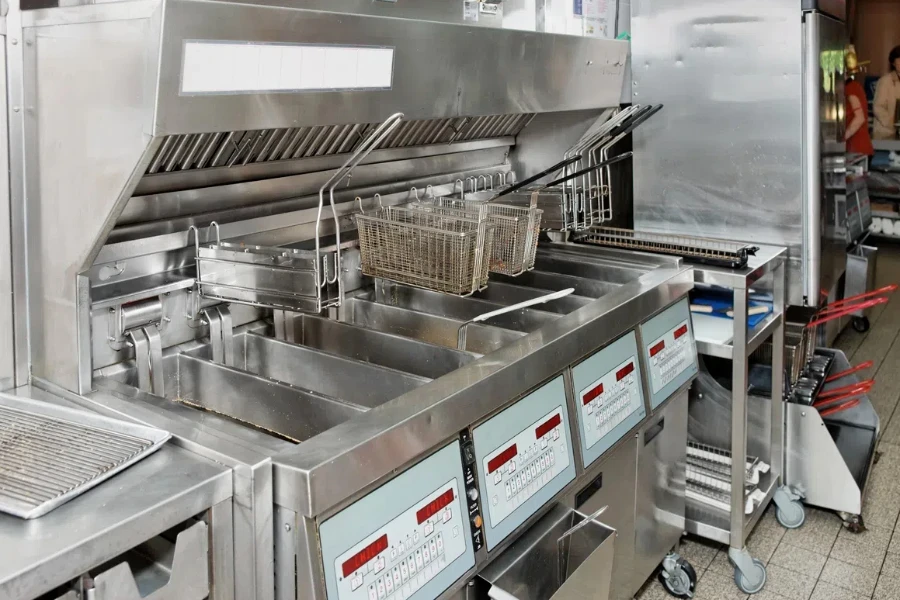
Smart Fryers
Smart fryers are revolutionizing the commercial kitchen landscape with their advanced features and connectivity. These fryers are equipped with IoT capabilities, allowing for remote monitoring and control via smartphones or tablets. This connectivity ensures that operators can adjust cooking parameters, receive maintenance alerts, and monitor energy consumption in real-time, enhancing operational efficiency.
Moreover, smart fryers often come with integrated sensors and AI algorithms that optimize frying processes. These sensors can detect the type of food being fried and automatically adjust temperature and cooking time to ensure consistent quality. For instance, a smart fryer can differentiate between frying chicken and potatoes, adjusting its settings accordingly to achieve the perfect crispiness and flavor.
In addition to operational benefits, smart fryers contribute to food safety and compliance. They can log cooking data and generate reports that help in maintaining HACCP (Hazard Analysis Critical Control Point) standards. This data logging capability is crucial for audits and ensuring that food safety protocols are strictly followed, reducing the risk of foodborne illnesses.
Energy-efficient Models
Energy-efficient fryers are becoming increasingly popular due to their cost-saving and environmental benefits. These models are designed to use less energy while maintaining high performance, often incorporating advanced insulation and heat recovery systems. For example, some energy-efficient fryers use infrared technology to reduce heat loss and improve cooking efficiency.
The adoption of energy-efficient fryers can lead to significant reductions in operational costs. According to industry data, energy-efficient models can reduce energy consumption by up to 30% compared to traditional fryers. This reduction not only lowers utility bills but also contributes to a smaller carbon footprint, aligning with global sustainability goals.
Furthermore, many energy-efficient fryers are eligible for rebates and incentives from utility companies and government programs. These financial incentives can offset the initial investment cost, making it more feasible for businesses to upgrade their equipment. By investing in energy-efficient fryers, businesses can achieve long-term savings and enhance their sustainability credentials.
Cost Analysis and Budgeting
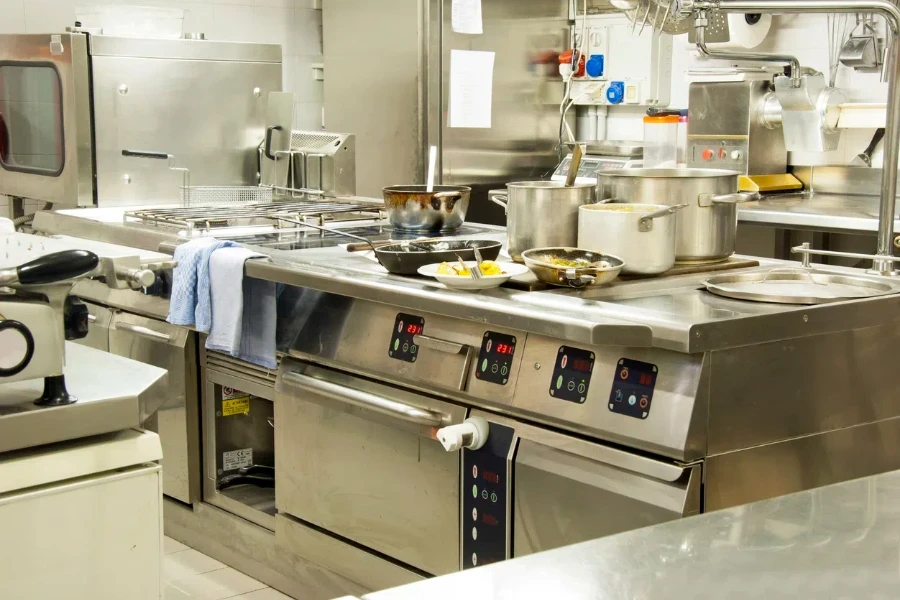
Initial Investment
The initial investment in commercial fryers can vary significantly based on the type and features of the fryer. High-end models with advanced features such as smart technology and energy efficiency tend to have a higher upfront cost. For instance, a smart fryer with IoT capabilities and AI integration can cost between $5,000 and $10,000, whereas a basic model might be priced around $1,500 to $3,000.
When budgeting for a new fryer, it’s essential to consider not only the purchase price but also the installation costs. Installation may require modifications to existing kitchen infrastructure, such as electrical upgrades or ventilation improvements. These additional costs can range from a few hundred to several thousand dollars, depending on the complexity of the installation.
It’s also important to factor in the potential savings from energy-efficient models. Although the initial cost may be higher, the reduction in energy consumption can lead to significant savings over time. For example, an energy-efficient fryer that saves $500 annually in energy costs can offset the higher purchase price within a few years, making it a cost-effective investment in the long run.
Long-term Operational Costs
Long-term operational costs of commercial fryers include energy consumption, maintenance, and oil usage. Energy consumption is a major factor, with traditional fryers consuming more electricity or gas compared to energy-efficient models. Regular maintenance is also crucial to ensure optimal performance and longevity of the equipment, with annual maintenance costs typically ranging from $200 to $500.
Oil usage is another significant operational cost, as fryers require regular oil changes to maintain food quality and safety. The frequency of oil changes depends on the volume of frying and the type of food being cooked. On average, a commercial fryer may require oil changes every 20 to 30 hours of use, with each oil change costing between $50 and $100.
Additionally, smart fryers can help reduce long-term operational costs through predictive maintenance and optimized cooking cycles. By monitoring the condition of the fryer and predicting when maintenance is needed, these fryers can prevent costly breakdowns and extend the lifespan of the equipment. Optimized cooking cycles also reduce oil degradation, leading to fewer oil changes and lower overall costs.
Making an Informed Purchase Decision
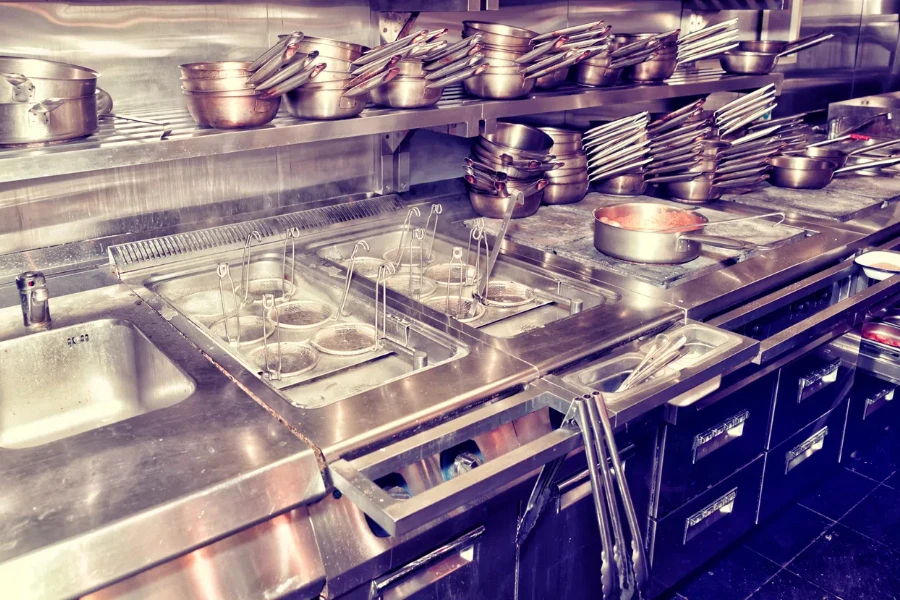
When making an informed purchase decision for commercial fryers, it’s essential to consider both the initial investment and long-term operational costs. Evaluating the total cost of ownership, including energy consumption, maintenance, and oil usage, can help determine the most cost-effective option. Additionally, considering the benefits of advanced features such as smart technology and energy efficiency can lead to significant savings and improved operational efficiency in the long run.
